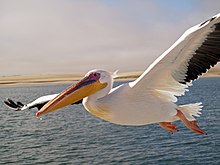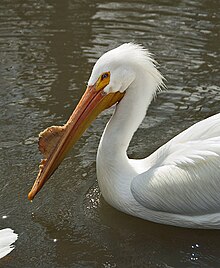ဇင်မံင်
ဇင်မံင် (Pelicans) (ဗမာ ဌက်ကြီးဝံပို) ဝွံ ဒှ်ဂကူဂစေံဍာ် ဇၞော်ဇၞော် နွံဂၠိုင်ကဵု ဂကူ မလုပ်လၟိဟ် တၞောဝ်ဗဳဇ Pelecanidae ရ။ ဂစေံဇင်မံင် ဂှ် နွံကဵု ခၟူဂၠိင်င် ထိုင်ပါင်ဇၞော်ဇၞော် သွက်ဂွံ ဗက်ရပ်စက၊ ဂိုင်ဍာ် ကိုပ်ကၠာ ဟွံဂွံၚိတ်ဖျေဟ်ရ။
| Pelican | |
|---|---|

| |
| A great white pelican in breeding condition flying over Walvis Bay, Namibia. | |
| Scientific classification | |
| Kingdom: | Animalia |
| Phylum: | Chordata |
| Class: | Aves |
| Order: | Pelecaniformes |
| Family: | Pelecanidae Rafinesque, 1815 |
| Genus: | Pelecanus Linnaeus, 1758 |
| Type species | |
| Pelecanus onocrotalus | |
| Species | |
|
8, see text | |
| |||||||||||||||||||||||||||||||||||||||||||||
| Evolutionary relationships among the extant species based on Kennedy et al. (2013).[၁] |
| Living species of Pelecanus | |||
|---|---|---|---|
| Common and binomial names[၂] | Image | Description | Range and status |
| American white pelican Pelecanus erythrorhynchos Gmelin, 1789 |
 |
Length 1.3–1.8 မဳတာs (4.3–5.9 ft), wingspan 2.44–2.9 မဳတာs (8.0–9.5 ft), weight 5–9 kiloဂရာမ်s (11–20 lb).[၃] Plumage almost entirely white, except for black primary and secondary remiges only visible in flight. | Monotypic. Inland North America, wintering in Mexico. Status: Least Concern. |
| Brown pelican Pelecanus occidentalis Linnaeus, 1766 |
 |
Length up to 1.4 မဳတာs (4.6 ft), wingspan 2–2.3 မဳတာs (6.6–7.5 ft), weight 3.6–4.5 kiloဂရာမ်s (7.9–9.9 lb).[၄] Smallest pelican; distinguished by brown plumage; feeds by plunge-diving.[၅] | Five subspecies. Coastal distribution ranging from North America and the Caribbean to northern South America and the Galapagos. Status: Least Concern. |
| Peruvian pelican Pelecanus thagus Molina, 1782 |
 |
Length up to 1.52 မဳတာs (5.0 ft), wingspan 2.48 မဳတာs (8.1 ft),[၆] average weight 7 kiloဂရာမ်s (15 lb).[၇] Dark with a white stripe from the crown down the sides of the neck. | Monotypic. Pacific Coast of South America from Ecuador and Peru south through to southern Chile.[၈] Status: Near Threatened. |
| Great white pelican Pelecanus onocrotalus Linnaeus, 1758 |
 |
Length 1.40–1.75 မဳတာs (4.6–5.7 ft), wingspan 2.45–2.95 မဳတာs (8.0–9.7 ft), weight 10–11 kiloဂရာမ်s (22–24 lb).[၉][၁၀] Plumage white, with pink facial patch and legs. | Monotypic. Patchy distribution from eastern Mediterranean east to Indochina and Malay Peninsula, and south to South Africa. Status: Least Concern. |
| Australian pelican Pelecanus conspicillatus Temminck, 1824 |
 |
Length 1.60–1.90 မဳတာs (5.2–6.2 ft), wingspan 2.5–3.4 မဳတာs (8.2–11.2 ft), weight 4–8.2 kiloဂရာမ်s (8.8–18.1 lb).[၁၁] Predominantly white with black along primaries and very large, pale pink bill. | Monotypic. Australia and New Guinea; vagrant to New Zealand, Solomons, Bismarck Archipelago, Fiji and Wallacea. Status: Least Concern. |
| Pink-backed pelican Pelecanus rufescens Gmelin, 1789 |
 |
Length 1.25–1.32 မဳတာs (4.1–4.3 ft), wingspan 2.65–2.9 မဳတာs (8.7–9.5 ft), weight 3.9–7 kiloဂရာမ်s (8.6–15.4 lb). Grey and white plumage, occasionally pinkish on the back, with a yellow upper mandible and grey pouch. | Monotypic. Africa, Seychelles and southwestern Arabia; extinct in Madagascar.[၁၂] Status: Least Concern. |
| Dalmatian pelican Pelecanus crispus Bruch, 1832 |
 |
Length 1.60–1.80 မဳတာs (5.2–5.9 ft), wingspan 2.70–3.20 မဳတာs (8.9–10.5 ft), weight 10–12 kiloဂရာမ်s (22–26 lb). Largest pelican; differs from great white pelican in having curly nape feathers, grey legs and greyish-white plumage.[၁၃] | Monotypic. South-eastern Europe to India and China. Status: Near Threatened. |
| Spot-billed pelican Pelecanus philippensis Gmelin, 1789 |
 |
Length 1.27–1.52 မဳတာs (4.2–5.0 ft), wingspan 2.5 မဳတာs (8.2 ft), weight c. 5 kiloဂရာမ်s (11 lb).[၁၄] Mainly grey-white all over, with a grey hindneck crest in breeding season, pinkish rump and spotted bill pouch. | Monotypic. Southern Asia from southern Pakistan across India east to Indonesia; extinct in the Philippines and possibly eastern China. Status: Near Threatened. |




Pelicans are very large birds with very long bills characterised by a downcurved hook at the end of the upper mandible, and the attachment of a huge gular pouch to the lower. The slender rami of the lower bill and the flexible tongue muscles form the pouch into a basket for catching fish, and sometimes rainwater,[၁၆] though not to hinder the swallowing of large fish, the tongue itself is tiny.[၁၇] They have a long neck and short stout legs with large, fully webbed feet. Although they are among the heaviest of flying birds, they are relatively light for their apparent bulk because of air pockets in the skeleton and beneath the skin, enabling them to float high in the water. The tail is short and square. The wings are long and broad, suitably shaped for soaring and gliding flight, and have the unusually large number of 30 to 35 secondary flight feathers.[၁၈]
Males are generally larger than females and have longer bills.[၁၉] The smallest species is the brown pelican, small individuals of which can be no more than 2.75 kiloဂရာမ်s (6.1 lb) and 1.06 မဳတာs (3.5 ft) long, with a wingspan of as little as 1.83 မဳတာs (6.0 ft). The largest is believed to be the Dalmatian, at up to 15 kiloဂရာမ်s (33 lb) and 1.83 မဳတာs (6.0 ft) in length, with a maximum wingspan of 3 မဳတာs (9.8 ft). The Australian pelican's bill may grow up to 0.5 မဳတာs (1.6 ft) long in large males,[၂၀] the longest of any bird.[၂၁]
Pelicans have mainly light-coloured plumage, the exceptions being the brown and Peruvian pelicans. The bills, pouches, and bare facial skin of all species become brighter before breeding season commences.[၂၂] The throat pouch of the Californian subspecies of the brown pelican turns bright red, and fades to yellow after the eggs are laid, while the throat pouch of the Peruvian pelican turns blue. The American white pelican grows a prominent knob on its bill that is shed once females have laid eggs.[၂၃] The plumage of immature pelicans is darker than that of adults.[၂၄] Newly hatched chicks are naked and pink, darkening to grey or black after 4 to 14 days, then developing a covering of white or grey down.[၂၅]
Air sacs
ပလေဝ်ဒါန်Anatomical dissections of two brown pelicans in 1939 showed that pelicans have a network of subcutaneous air sacs under their skin situated across the ventral surface including the throat, breast, and undersides of the wings, as well as having air sacs in their bones. The air sacs are connected to the airways of the respiratory system, and the pelican can keep its air sacs inflated by closing its glottis, but how air sacs are inflated is not clear.[၂၆] The air sacs serve to keep the pelican remarkably buoyant in the water[၂၇] and may also cushion the impact of the pelican's body on the water surface when they dive from flight into water to catch fish. Superficial air sacs may also help to round body contours (especially over the abdomen, where surface protuberances may be caused by viscera changing size and position) to enable the overlying feathers to form more effective heat insulation and also to enable feathers to be held in position for good aerodynamics.
Distribution and habitat
ပလေဝ်ဒါန်Modern pelicans are found on all continents except Antarctica. They primarily inhabit warm regions, although breeding ranges extend to latitudes of 45° South (Australian pelicans in Tasmania) and 60° North (American white pelicans in western Canada).[၂၈] Birds of inland and coastal waters, they are absent from polar regions, the deep ocean, oceanic islands (except the Galapagos), and inland South America, as well as from the eastern coast of South America from the mouth of the Amazon River southwards.[၁၆] Subfossil bones have been recovered from as far south as New Zealand's South Island,[၂၉] although their scarcity and isolated occurrence suggests that these remains may have merely been vagrants from Australia (much as is the case today).[၃၀]
Behaviour and ecology
ပလေဝ်ဒါန်Breeding and lifespan
ပလေဝ်ဒါန်
နိဿဲ
ပလေဝ်ဒါန်- ↑ နိဿဲ ဗၠေတ် - Invalid
<ref>tag; no text was provided for refs namedkennedy - ↑ Zoological Nomenclature Resource: Pelecaniformes (Version 2.003). zoonomen.net (14 December 2011). Retrieved on 21 May 2012။
- ↑ Common Coastal Birds of Florida & the Caribbean. Pineapple Press။ 29 June 2012 တင်နိဿဲဏအ် ကလေင်စၟဳစၟတ်တုဲ။
- ↑ Brown Pelican. US Fish & Wildlife Service (November 2009). Retrieved on 9 June 2012။
- ↑ A Guide to the Birds of Panama: With Costa Rica, Nicaragua, and Honduras. Princeton University Press။ 29 June 2012 တင်နိဿဲဏအ် ကလေင်စၟဳစၟတ်တုဲ။
- ↑ A Wildlife Guide to Chile: Continental Chile, Chilean Antarctica, Easter Island, Juan Fernández Archipelago. Princeton University Press။ 29 June 2012 တင်နိဿဲဏအ် ကလေင်စၟဳစၟတ်တုဲ။
- ↑ Peruvian Pelican. Mundo Azul (17 October 2010). Retrieved on 9 June 2012။
- ↑ Distribution and Taxonomy of Birds of the World. Yale University Press။ 29 June 2012 တင်နိဿဲဏအ် ကလေင်စၟဳစၟတ်တုဲ။
- ↑ The Birds of the Western Palearctic concise edition (2 volumes). Oxford University Press။
- ↑ Collins Bird Guide. Collins။
- ↑ Australian Pelican. Unique Australian Animals. Retrieved on 10 June 2012။
- ↑ Guide to the Birds of Madagascar. Yale University Press။ 29 June 2012 တင်နိဿဲဏအ် ကလေင်စၟဳစၟတ်တုဲ။
- ↑ The Handbook of Bird Identification: For Europe and the Western Palearctic. A&C Black။ 29 June 2012 တင်နိဿဲဏအ် ကလေင်စၟဳစၟတ်တုဲ။
- ↑ Birds of East Asia. A&C Black။ 29 June 2012 တင်နိဿဲဏအ် ကလေင်စၟဳစၟတ်တုဲ။
- ↑ You must specify title = and url = when using {{cite web}}..
- ↑ ၁၆.၀ ၁၆.၁ (1990) Handbook of Australian, New Zealand and Antarctic Birds. Volume 1, Ratites to Ducks, Marchant, S.; Higgins, P.J. (Coordinators)., Melbourne, Victoria: Oxford University Press, 737–38. ISBN 0-19-553068-3။ နိဿဲ ဗၠေတ် - Invalid
<ref>tag; name "hanzab1a" defined multiple times with different content - ↑ (1965) The Bird, its Form and Function. New York, New York: Dover Publications။
- ↑ (2009) The Princeton Encyclopedia of Birds. Princeton University. ISBN 978-0691140704။
- ↑ (1990) Handbook of Australian, New Zealand and Antarctic Birds. Volume 1, Ratites to Ducks, 737–38။
- ↑ (1990) Handbook of Australian, New Zealand and Antarctic Birds. Volume 1, Ratites to Ducks။
- ↑ (2003) Firefly Encyclopedia of Birds, 78–81။
- ↑ [1985] (1998) Encyclopedia of Birds. New York, New York: Facts on File, 53–54. ISBN 0-8160-1150-8။
- ↑ "An Overview of the American White Pelican" (2005): 9–17.
- ↑ (2010) Marine Biology: A Derivative of the Encyclopedia of Ocean Sciences. London, United Kingdom: Academic Press, 524–30. ISBN 978-0-08-096480-5။
- ↑ (1985) A Dictionary of Birds. Calton, United Kingdom: Poyser. ISBN 0-85661-039-9။
- ↑ "Functional Aspects of the Pneumatic System of the California Brown Pelican" .
- ↑ Canadian Feathers : a Loon-atics Guide to Anting, Mimicry and Dump-nesting. Simply Wild Publications။
- ↑ (2003) Firefly Encyclopedia of Birds, 78–81။
- ↑ (1991) New Zealand's Extinct Birds။
- ↑ "New fossil records of pelicans (Aves: Pelecanidae) from New Zealand" (2002). Tuhinga: Records of the Museum of New Zealand Te PapaTongarewa 13: 39–44.